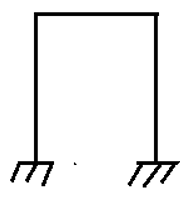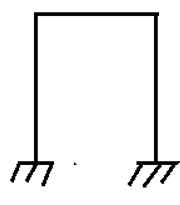1. What is kinematic indeterminacy for the given figure considering axial deformation?
a) 0
b) 4
c) 6
d) 10
Explanation: The given beam is supported by fixed support at both of it ends. Fixed support, if not considering axial deformation does not any degree of freedom. Therefore, the degree of freedom of the beam is 0.
2. What is kinematic indeterminacy for the given figure?
a) 0
b) 1
c) 2
d) 3
Explanation: The given beam is supported by fixed supports at both of its ends and intermediary roller support. Fixed does not provide any degree of freedom. Whereas, roller support provides both rotation and horizontal sway. But horizontal sway is already restricted by the ends fixed support. Thus, the only degree of freedom is the rotation about roller support.
3. The degree of freedom of a joint for the rigid jointed joint plane frame is _____
a) 0
b) 2
c) 3
d) 6
Explanation:Number of degree of freedom of a joint for the rigid jointed plane frame is 3 i.e. Horizontal sway, Vertical sway, and Rotation.
4. What is kinematic indeterminacy for the given figure without considering axial deformation?
a) 0
b) 2
c) 4
d) 6
Explanation: The given set of frame consists of fixed end supports with two intermediate rigid joints. Each rigid joint allows horizontal sway, vertical sway, and rotation. Therefore, two rigid joints will have six degrees of freedom.
5. What is kinematic indeterminacy for the given figure without considering axial deformation?
a) 0
b) 2
c) 3
d) 6
Explanation: The given set of frame consists of fixed end supports with two intermediate rigid joints. Each rigid joint allows horizontal sway, vertical sway, and rotation. But since the axial deformation is to be neglected. Therefore, vertical sway of the joints and either horizontal sway of a joint is neglected. Hence, degree of freedom is three.
6. The degree of freedom for a rigid jointed plane frame without axial deformation is given by 3j – m – r.
a) True
b) False
Explanation: The degree of freedom for a rigid jointed plane frame without axial deformation is given by 3j – r, where j is the number of joint and r is the number of reactions.
7. The degree of freedom of the given typical joint is ______
a) 1
b) 2
c) 3
d) 4
Explanation: Horizontal hinged joint provides four degrees of freedom. Four freedom at the horizontal hinged joint are horizontal sways of both connected members, vertical deflection of the joint and rotation of the joint.
8. The degree of freedom for a pin jointed plane frame is given by 3j – m – r.
a) True
b) False
Explanation: The degree of freedom for a pin jointed plane frame is given by 2j–r, where j is the number of joint and r is the number of reactions.
9. The degree of freedom for a pin jointed space frame is given by ____
a) 2j – r
b) 3j – r
c) 3j – m – r
d) 6j – r
Explanation: The degree of freedom for a pin jointed space frame is given by 3j – r, where j is the number of joints and r is the number of reactions.
10. In case of pin jointed plane frame, rotational displacement of the nodes are not considered.
a) True
b) False
Explanation: In case of pin jointed plane frame, rotational displacement of the nodes are not considered because member are not subjected to bending. Members are subjected to axial forces only.